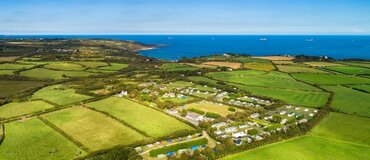
The Welsh National Trails weave through charming towns, past fascinating historical sites, and over some of the country’s most spectacular landscapes.
Here's our guide to each of the three.
Offa's Dyke Path
Sixty of the 177-miles of the Offa's Dyke Path trace the length of its namesake, Offa’s Dyke, an 8th-century earthwork that straddles the ancient border of England and Wales. The Anglo-Saxon King Offa built the dyke to demarcate the boundary of his kingdom, the Kingdom of Mercia, from the lands of his Welsh neighbours.
The path furrows its course south from the town of Prestatyn on the Irish Sea down to the Sedbury Cliffs on the Severn Estuary. The route passes through eight counties, back and forth across the English-Welsh border twenty times, over the Black Mountains of the Brecon Beacons National Park, and though the Shropshire Hills, the Clwydian Range, and the Eglwyseg Valley Areas of Outstanding Natural Beauty.
Along the way, you’ll pass through or close by to a number of sleepy old towns including Hay-on-Wye, Monmouth, and Montgomery. Other historical monuments that line the way include the imposing ramparts of Chepstow Castle and the romantic ruins of Tintern Abbey, the inspiration for one of William Wordsworth’s most famous poems. If you intend to walk Offa's Dyke Path end to end, it’ll take you around 12 days.
Glyndŵr’s Way
Glyndŵr’s Way arcs west out from the English border in a big 135-mile loop through central Wales. The trail opened back in 2000 to commemorate the 600th anniversary of Welsh national hero Prince Owain Glyndŵr’s ill-fated rebellion against King Henry IV of England.
The trail starts at Knighton then dot-to-dots its way over mostly hilly terrain between a series of villages and market towns. It reaches its end at Welshpool. Many of the natural landscapes it crosses are typically Welsh, including sessile oak forests, upland mire, heathlands, and heather moorlands.
Glyndŵr’s Way takes around 10 days to complete. If you’re an experienced walker who’s up for a bit of a challenge, this is one for you.
The Pembrokeshire Coast Path
The Pembrokeshire Coast Path traces almost the entire sea-facing rim of The Pembrokeshire Coast National Park, veering inland on just a handful of occasions. It comprises 186 miles of cliffs, beaches, coves, islets, and estuaries. All are unparalleled in beauty anywhere else in the country.
The area is also an Eden of marine wildlife inhabited by porpoises, dolphins, and seals. And many of the uninhabited islands that lie just off Pembrokeshire’s coast, including Skokholm, Skomer, and Ramsey Island, are protected bird sanctuaries, so you can also look forward to skies filled with flocks of seabirds, including puffins.
The numerous seaside towns and villages that lie along The Pembrokeshire Coast Path make this a particularly easy National Trail to divide up into shorter walks. Pembrokeshire achieved second place on National Geographic Magazine’s 2001 poll of the best coastal destinations on the planet, so expect nothing less than some of the most incredible coastal scenery the world has to offer.

As is also the case in England, the Welsh National Trails are waymarked by a series of signposts bearing an acorn symbol. Although the National Trails are long distance walkways and bridal paths, you’re free to dip in and out of them at your leisure. Whether you traverse the entire length or opt for a gentle stroll along a single mile, you’re bound to enjoy the experience either way.







